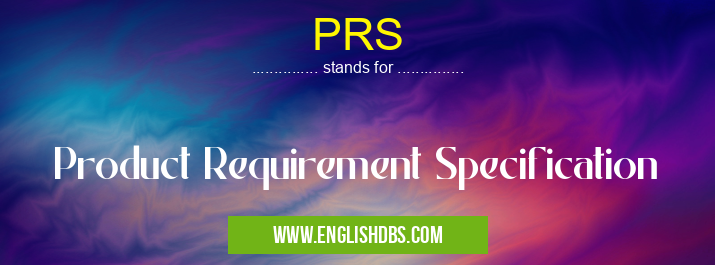What does PRS mean in ACADEMIC & SCIENCE
A Product Requirement Specification (PRS) is a document used to define the features, design, performance, and other aspects of a product before it is built. It outlines both functional and non-functional requirements that must be met for the product to be successful. The PRS is part of the software development life cycle (SDLC) process and serves as a guide for developers on what they need to create.

PRS meaning in Academic & Science in Academic & Science
PRS mostly used in an acronym Academic & Science in Category Academic & Science that means Product Requirement Specification
Shorthand: PRS,
Full Form: Product Requirement Specification
For more information of "Product Requirement Specification", see the section below.
Meaning
The term PRS stands for Product Requirement Specification. This is a document outlining all the features, components and functions that make up the proposed product. It includes all inputs, outputs, user interface elements, data flow diagrams, dependencies on other components and systems as well as any other technical details needed for development. The PRS also outlines how certain aspects of the product will function such as performance criteria and quality control measures. Depending on the complexity of the product this could take several weeks or months to complete.
Scope
A PRS is often created at the beginning of a project in order to provide a blueprint or roadmap for developers to follow when implementing features. This document acts like an instruction manual for developers who are responsible for creating code that meets specific requirements stated within it. The purpose of writing down these details in advance is so that everyone involved understands exactly what needs to be done in order to build a successful product with minimal effort spent on rework or troubleshooting issues later in the process.
Essential Questions and Answers on Product Requirement Specification in "SCIENCE»SCIENCE"
What is a Product Requirement Specification (PRS)?
A Product Requirement Specification (PRS) is a document that describes in detail the necessary functions, features and characteristics that must be included within a product or service. It typically covers what problem the product needs to solve, how it should be designed and what features it should include.
What goes into a PRS?
A PRS includes details such as the product's purpose, its user interface design requirements, performance requirements and safety requirements. It can also include information about how the product will be manufactured, tested and distributed.
What are some common sections in a PRS?
Typical sections in a PRS include an introduction, purpose of the project, list of functional requirements, list of non-functional requirements (safety, security, usability), compatibility with any existing products or services, quality assurance criteria and user interface design guidelines.
Who should create a PRS?
The PRS should be created by the stakeholders in consultation with all relevant parties including product owners, developers and testers. In particular it should involve those responsible for production decisions such as engineering managers or assembly line supervisors.
How do you ensure that all stakeholders are represented when creating a PRS?
It is important to ensure that all stakeholders have access to the document throughout its creation process. This can be done through holding meetings with key stakeholders regularly and ensuring that any relevant expertise is properly consulted on matters related to design specifications as well as any changes that need to occur during development of the product or service.
When should you review your PRS?
The best time to review your PRS is at different stages during product development - from start up to finish. Regular reviews help ensure that all design changes comply with regulations and customer demands while incorporating new technologies which allow optimize processes throughout development lifecycle.
How do you ensure accuracy and completeness in your PRS?
To ensure accuracy and completeness in your PRS you can apply techniques such as requirement traceability which allows you to identify discrepancies between customer needs and expectations for your product; risk management which helps identify potential risks associated with your project; generating test scenarios which help validate what has been documented; ensuring traceability between different versions of documents; and verification which involves comparing designs against real world applications/data sets.
What approaches help making sure that no unnecessary elements have been included within a PRS?
Good practices like adherence to industry standards for documentation layout (e.g., ISO 27000) or using templates based on previous successful projects can help make sure there are no unnecessary elements included within a PRSuite specification document. Furthermore functional decomposition – breaking down complex problems into smaller components – allows better understanding efficiency optimization aspects not apparent at first glance.
Should I use standard software tools when writing my own requirements specification?
Yes! By using standard software tools like word processors or text editors you can maintain consistency across documents while having easy accessibility for reviewing or editing purposes; thus avoiding costly errors due to outdated data being used incorrectly.
Final Words:
In short, Product Requirement Specifications provide guidance and direction throughout each stage of development from concept through completion ensuring that all stakeholders understand their role in bringing an idea from concept to reality. By setting expectations up front related to cost, timeline resources needed etc., it allows teams working together towards a common goal which increases efficiency and overall success rate of projects going forward.
PRS also stands for: |
|
| All stands for PRS |
